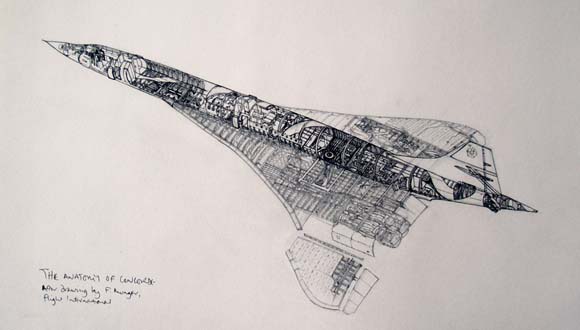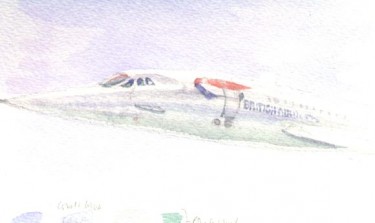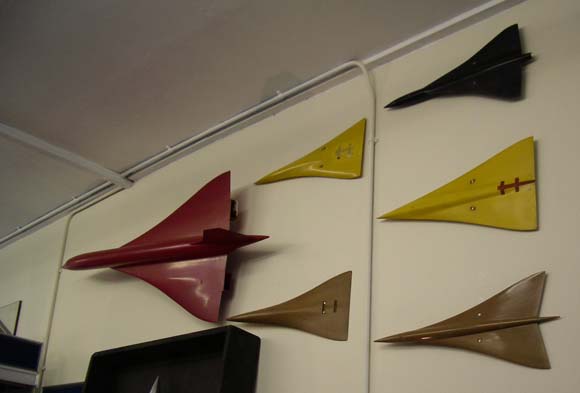7 Learning from the experts
As I got drawn in – so to speak – I began to study the Concordes in closer detail, learning from the people who worked with them and from the aeroplanes themselves.
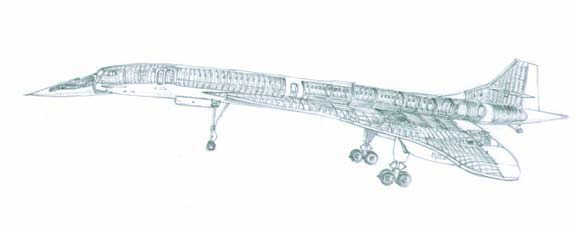
Cut-away scale model of Concorde
Created by Ken Wagner, this cut-away model is in London’s Science Museum, in the Flight Gallery. I felt I should study it as a way to understand Concorde more deeply – just as I did with horses, learning about their anatomy to help my painting. Besides, I loved the challenge of mastering all the intricate details. Sitting there with a Harrier aircraft dangling over my head, and other flying machines and aero engines all around me, I felt like a visitor to a strange, dazzling world of human brilliance and ingenuity.
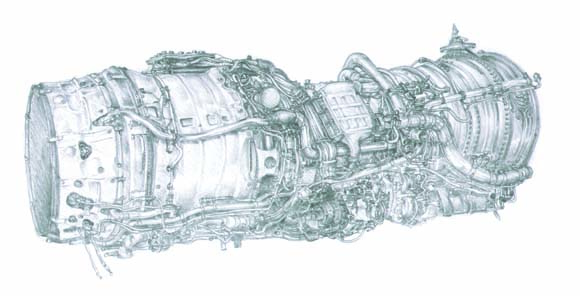
Olympus engine
This is the engine that was used in the prototype Concordes; it is also in the Science Museum. I spent five days drawing the engine from life. As I plotted the shapes and studied the lines of the wiring, pipework, and other mysterious components, I was humbly aware that I was – literally – just scratching the surface. I had no idea how this engine worked, and felt huge respect for the people who did understand it.
Copy of a drawing from Flight International magazine
This plan took me over a month. I copied it from a drawing created by Frank Munger for Flight International, and reproduced in The Concorde Story by Christopher Orlebar. Again, I loved delving into the details – it was like discovering the anatomy of a whole new life-form. Frank Munger died in June 2010, at the age of 90. He was renowned as one of the world’s finest cut-away artists, and I am very glad to have learned from him.
At the same time, I was slowly getting better at drawing Concorde from life. This colour sketch of Alpha Charlie was done just after she went on display at Manchester.
The Guild of Aviation Artists
I belong to the Guild of Aviation Artists, who run workshops and study days throughout the year, and hold exhibitions at the Mall Galleries each summer. My first study day was at the Farnborough Air Sciences Trust museum in Hampshire. The activity was led by the late Stephen Arch. I was also privileged to meet Mrs Angela Jeffreys, daughter of Sir George Edwards; Sir George was the head of the British Aircraft Corporation, and the mastermind behind Concorde, the VC-10, the Viscount and the Valiant. (She saw my sketch of Brian Trubshaw, for my picture “First flight”, and immediately smiled and said, “Oh, I know who that is!” She had very fond memories of him, as he had been a great friend of the family.)

Most of the other attendees went to paint the aircraft outside. However, because it was a bit rainy and because I am only a girl, I stayed inside to draw the artefacts in the museum. In one room, I was delighted to find one of Frank Whittle’s jet engines, plus some of the small wind-tunnel models used in the development of Concorde. According to one of the men at the museum, these items were left in a box for years, and were about to be thrown out until someone realised what they were and saved them.
Swept-wing wind-tunnel model >>
Farnborough Air Sciences Trust: delta wing development models

